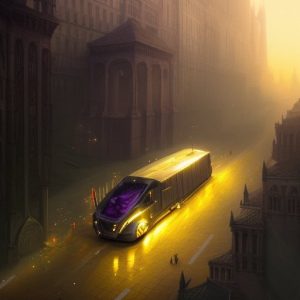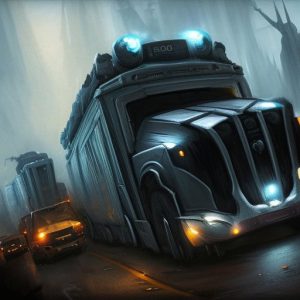
Traffic congestion has been a problem for decades yet the solution may have been overlooked. The Catbus, a mythical creature-turned-transportation-machine, is an underutilized mass transit solution. Benefits include reduced congestion and increased convenience for commuters. However, public skepticism and negative perception around the reliability of the system remain a challenge. To overcome these barriers, it’s crucial to present Catbus as a viable alternative through marketing and education. If implemented, it could revolutionize public transit and inspire innovation in the transportation industry. Therefore, exploring the potential benefits of Catbus and ways to implement it into existing transportation infrastructure is critical.
I. Introduction
Buckle up and grab your space helmets, folks, because we’re about to embark on a wild ride through the galaxy of transportation!

Picture this: you’re zooming down the highway in your trusty hovercar, feeling the wind in your hair and the rubber beneath your wheels. Except, uh-oh, it turns out everyone else had the same idea, and now you’re caught in a gridlock of cosmic proportions. Suddenly your cool futuristic ride feels like a rusty old jalopy.
But fear not, fellow travelers, because we may have found a solution to this interstellar nightmare: Catbus.
Wait, what the heck is a Catbus, you might ask? Well, according to the animated classic My Neighbor Totoro, it’s a magical creature who can seamlessly blend into forest environments and transport multiple passengers in its fluffy belly. But in our reality, it could be the answer to our transportation woes.
Think about it: Catbuses are lightweight, efficient, and flexible – able to navigate tight spaces and avoid congestion. Plus, with their adorable exterior and whimsical design, who wouldn’t want to hop on board for a ride to the stars (or just to the grocery store)?
So why hasn’t Catbus already taken over as the go-to method of mass transit? It may be due to the lack of awareness or public trust placed in this unconventional mode of transportation. But if we embrace the Catbus with open arms (and paws), we could revolutionize our daily commutes and ease the burden on our current transportation systems.
So join me on this journey as we explore the benefits, misconceptions, and potential future of the Catbus as a solution to traffic congestion. Trust me, it’s not just child’s play – it’s redefining the way we move through the cosmos.
II. The Misunderstood Catbus
The Catbus: a creature of legend and whimsy, beloved by children and adults alike. But despite its popularity in popular culture, it remains a largely underutilized solution to our transportation needs.

First, let’s delve into the history of the Catbus. It originated from the imaginative mind of Hayao Miyazaki, a renowned anime filmmaker. In the film My Neighbor Totoro, the Catbus was a magical creature who could transport multiple passengers within its fluffy belly. From there, it captured the hearts of viewers and became a beloved icon of Japanese pop culture.
But outside of the movies, the Catbus has struggled to gain ground as a viable transportation option. Perhaps its whimsical nature and lack of conventional design have made it a difficult choice for mass transit planners. But let’s not forget the benefits: its light weight and flexibility make it an ideal solution for navigating tight spaces and avoiding congestion.
Perhaps the Catbus simply needs more exposure and education for the public to embrace it. In a world where gridlock and emissions continue to plague our car-centric culture, we can’t afford to ignore potential solutions, no matter how unconventional they may seem.
So let’s not overlook the Catbus as a mass transit option. Who knows – it could be the key to unlocking a new era of transportation that’s just as inspiring as the films that gave rise to its legend.
III. Benefits of Catbus
Catbus may seem like just a cute and cuddly creature, but it has a lot to offer in terms of transportation benefits. For starters, it can drastically reduce traffic congestion, which is a common problem in our bustling cities and spaceports.

Because Catbus is lightweight and nimble, it can easily navigate through crowded streets and tight spaces, allowing more people to reach their destination in a shorter amount of time. This means less time spent sitting in traffic and more time for other important tasks (like saving the galaxy from alien invaders).
Furthermore, Catbus is incredibly versatile in terms of the number of passengers it can carry. Depending on the size and design of the Catbus, it can accommodate a range of commuters from small groups to entire clans. This means fewer cars on the road and less stress on the environment, as well as reducing the cost of transportation for groups of people.
Another benefit of Catbus is the increased convenience it offers to commuters. With more Catbuses available throughout the city, people can experience a faster and more efficient method of transportation than other outdated systems. Those who may struggle with walking long distances or carrying heavy bags will find the Catbus to be the perfect solution.
Finally, Catbus is incredibly eco-friendly, emitting fewer pollutants than traditional transportation methods, which is vital in maintaining clean and healthy air in our cities.
IV. Overcoming Public Skepticism
One of the biggest obstacles that Catbus faces is the public’s perception of it as an unreliable or outdated mode of transportation. The truth is, however, that Catbus has come a long way since its humble beginnings. But how can we convince people of its value? It’s all about marketing and education.

First and foremost, we need to dispel the myths surrounding Catbus. Many people have a preconceived notion that it’s slow or prone to breakdowns. But in reality, Catbus has undergone extensive upgrades and maintenance to ensure a smooth and efficient ride. We need to get the word out about these improvements and highlight the benefits of choosing Catbus as a reliable means of public transportation.
Another factor contributing to public skepticism is a lack of exposure. Catbus simply doesn’t have the same brand recognition as other transportation options, making it a lesser-known choice. We need to increase Catbus’s visibility and make it a more familiar sight in communities. This means investing in eye-catching branding and advertising, as well as expanding Catbus routes to serve more neighborhoods and gathering places.
But beyond just getting people on board with the idea of Catbus, we need to educate riders on how to effectively utilize the system. Many people may not know how to navigate the various routes and schedules, leading to frustration and dissatisfaction. By offering user-friendly resources such as mobile apps or interactive displays at stops, we can empower riders to make informed choices and enjoy their experience on Catbus.
It’s important to remember that overcoming public skepticism is not a one-time fix. It’s an ongoing effort that requires continuous improvement and communication. With the right marketing and education strategies, we can change the conversation around Catbus and establish it as a reliable and enjoyable choice for public transportation.
V. Implementing Catbus as a Solution
To make Catbus a viable alternative to conventional transportation, we must first integrate it into existing infrastructure. This means building new Catbus stations and stops, developing routes that connect to major hubs, and updating maps and schedules to reflect Catbus availability.

But integration doesn’t just stop at physical changes. We must also promote Catbus as a reliable and efficient way to get around, through targeted advertising and positive reviews from satisfied riders. Word of mouth can be a powerful tool in gaining public acceptance.
One way to incentivize Catbus ridership could be through discounted or bundled pricing, encouraging riders to use Catbus in conjunction with other forms of transportation. This can be accomplished by partnering with existing ride-sharing services or offering package deals with train and bus fares.
In order to make Catbus truly accessible, we must also tackle the issue of affordability. While Catbus may be more cost-effective in the long run, implementing a sliding scale payment system or fare subsidies can help alleviate the burden of upfront costs for low-income riders.
Finally, we must constantly evaluate and improve upon the Catbus system to make it as efficient and convenient as possible. This can include upgrades to the vehicles themselves, such as incorporating new technology or expanding capacity, as well as analyzing ridership data to optimize routes and scheduling.
Implementing Catbus as a solution to traffic congestion may require some upfront investment, but the long-term benefits in reduced gridlock and increased accessibility make it a worthwhile venture. By working together to integrate and promote Catbus as a viable alternative, we can create a brighter future for transportation in our galaxy.
VI. The Future of Catbus
The future of Catbus is looking as bright as the sun of Tatooine. There are many potential innovations and upgrades that could take this already exciting mode of transportation to the next level.

One possibility is the incorporation of self-driving technology. Imagine hopping into a Catbus and letting it take the wheel (or, uh, fur?). This could lead to even more efficient routing and less congested roads. Plus, it would free up passengers to relax, read a book, or gaze out the window at the cosmos passing by.
Another innovation could be the integration of solar-powered technology. Catbuses could harness the energy of the stars to power their systems, making them even more eco-friendly and sustainable. This would help reduce the carbon footprint of our transportation networks and pave the way for a cleaner, brighter future.
And let’s not forget about the potential for augmented reality (AR) technology. Picture a Catbus ride where the windows are transformed into immersive, interactive displays – giving passengers the sensation of soaring through space or swimming with dolphins. This would add a new level of excitement and entertainment to our daily commutes.
Of course, these are just a few of the many possible innovations that could transform Catbus from a fun novelty to a true game-changer in the world of public transportation. With advances in technology and a willingness to think outside the box (or the TARDIS, or the Millennium Falcon), the sky’s the limit for where Catbus can go next. So buckle up and get ready – this is a journey you won’t want to miss.
VII. Conclusion
So, we’ve reached the end of our journey, and what a ride it’s been. We’ve explored the potential of Catbus as a solution to traffic congestion, delved into the misconceptions surrounding this whimsical mode of transportation, and even envisioned a future where Catbus reigns supreme.

But the real lesson here is the importance of thinking outside the box when it comes to solving transportation issues. We can’t rely on the same old systems to carry us into the future – we need to embrace innovation and creativity to truly revolutionize our daily commutes.
And that’s where Catbus comes in. It’s a prime example of how a seemingly unconventional idea can hold immense potential when we open our minds to it. By encouraging public trust and adoption of Catbus as a legitimate form of mass transit, we could drastically reduce traffic congestion and improve accessibility for all commuters.
Of course, it won’t be an easy road ahead. We’ll need to navigate the logistics of integrating Catbus into existing transportation infrastructure, address concerns over reliability and safety, and prove to skeptics that yes, a giant fluffball with eyes can indeed revolutionize our commutes. But with a little determination and a lot of imagination, we can make it happen.
So let’s band together, fellow space travelers, and embrace the potential of Catbus. It may seem like a fantastical dream, but with the right mindset and a willingness to explore unconventional solutions, we could make it a reality. Who knows, maybe one day we’ll look back on our current gridlock-laden highways and wonder how we ever survived without fluffy buses whisking us to our destinations. The future is bright, my friends – all we need to do is hop on board.






